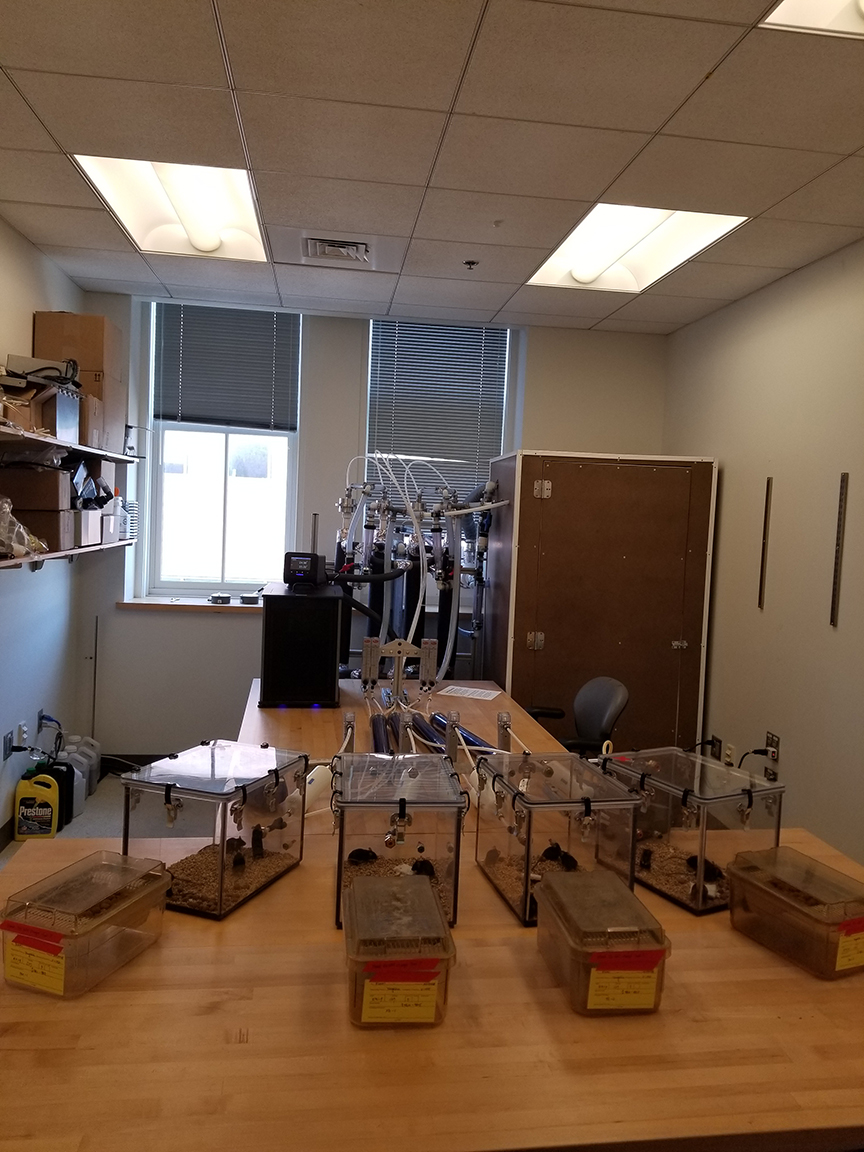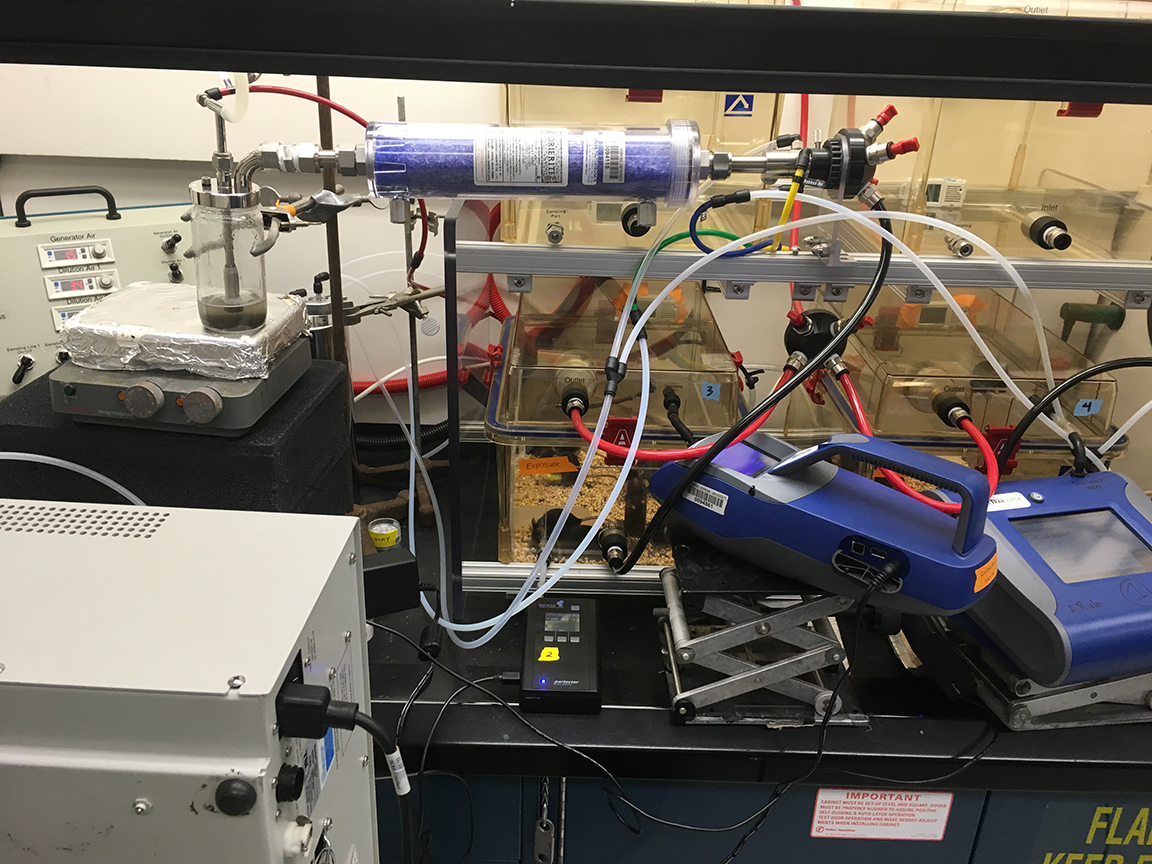Infrastructure for Delivering and Characterizing Airborne Exposures in Exposure Chambers
- ExpandAbout
- ExpandPrograms
- ExpandUndergraduate Programs
- ExpandGraduate Programs
- Application Fee Waiver Requirements
- Areas of Focus
- Graduate Student Resources
- Jensen Fellowship
- ExpandPostdoctoral Opportunitites
- Quotes from our EHE Alumni
- ExpandDoctor of Philosophy (PhD) in Environmental Health
- ExpandDoctor of Philosophy (PhD) in Geography and Environmental Engineering
- Master of Arts (MA) in Geography and Environmental Engineering
- ExpandMaster of Health Science (MHS) in Environmental Health
- Master of Science (MS) in Geography and Environmental Engineering
- ExpandMaster of Science (MS) in Occupational and Environmental Hygiene
- ExpandMaster of Science (MS) in Toxicology for Human Risk Assessment
- ExpandMaster of Science (ScM) in Environmental Health
- Master of Science in Engineering (MSE) in Geography and Environmental Engineering
- ExpandNon-Degree Programs
- Climate and Health Certificate Program
- Environmental and Occupational Health Certificate Program
- Food Systems, the Environment and Public Health Certificate Program
- Humane Sciences and Toxicology Policy Certificate Program
- Product Stewardship for Sustainability Certificate Program
- Public Health Preparedness Certificate Program
- Apply
- ExpandResearch and Practice
- EHE Research Retreat
- ExpandFaculty Research Interests
- ExpandDr. Kirsten Koehler Faculty Research
- Aerosol Samplers
- Baltimore Healthy Schools: Impact of Indoor Air Quality on Health and Performance
- Exposure Assessment for Epidemiologic Studies
- Exposures from Oil Spills
- Kirsten Koehler's Research Team
- Occupational Hazard Mapping
- Particulate Exposures in Asthmatic Kids (PEAK)
- Personal Exposure Assessment
- Publications
- Spatiotemporal Exposure Assessment
- Within Baltimore Variability in Pollution
- ExpandKohr Laboratory of Cardiovascular Redox Signaling
- ExpandOne Health Laboratory at Johns Hopkins University
- ExpandAnimal Visitation Chlorhexidine Trial
- Baltimore Healthy Schools: Impact of Indoor Air Quality on Health and Performance
- Collaborators
- Dr. Meghan Davis Receives Canine Health Foundation Grant to Study the Health of Dogs
- ExpandGroup on the Integration of the Relationship between Animals, Public Health and Ethics
- News and Publications
- ExpandOne Health Research Team
- ExpandThe COVET Study
- The CoWelf Study
- The Minority Pet-Owner Health Project
- Zoonotic Spillover Projects
- COVID-19 Human-Animal Interactions Survey (CHAIS)
- ExpandResearch Program Gurumurthy Ramachandran, PhD
- Climate Change, Pesticide Use, and Exposures
- Computed Tomography and Low-cost Sensor Networks to Reconstruct Spatial Pollutant Distributions
- Decision-making for Risk Management Using Small Data Sets, Mathematical Models, and Heuristics
- Infrastructure for Delivering and Characterizing Airborne Exposures in Exposure Chambers
- Mathematical Modeling of Chemical Exposures
- Meet Ram's Team...
- Modeling of Infectious Diseases
- ExpandThe Exposome Collaborative @ Johns Hopkins University
- ExpandThe Johns Hopkins Environmental Health Microbiology and Immunology Laboratory
- ExpandDr. Kirsten Koehler Faculty Research
- Geyh-Bouwer Trainee Practice Award
- Grand Rounds
- Mobile Air Pollution Measurement Laboratory
- ExpandResearch Areas
- Air Pollution and Cardiorespiratory Diseases
- Antimicrobial Resistance and Infectious Disease
- Biosecurity and Emerging Threats
- COVID-19 Research
- Carcinogens and Cancer
- Children's Environmental Health
- Chronic Disease Etiology and Prevention
- Community Sustainability, Resilience, and Preparedness
- Consumer Product Safety
- Energy Management and Alternative Technologies
- Environmental Chemistry, Microbiology and Ecology
- Environmental Engineering
- Environmental Epidemiology
- Environmental Inequities and Injustice
- Environmental Resource Quality
- Epigenetic Regulation in Environmental Diseases
- Food and Agricultural Systems
- Geomorphology, Geochemistry, and Hydrology
- ExpandGlobal Environmental Change
- Novel Exposure Assessment
- Risk Sciences and Public Policy
- Social and Behavioral Sciences
- Toxicology, Physiology, & Cell Biology
- ExpandWater, Sanitation, Hygiene, and Health
- Worker Health and Safety
- Teaching and Research Labs at WSE
- The INnovations to Generate Estimates of children's Soil/dust inTake (INGEST) Study
- Centers and Institutes
- ExpandPeople
- News and Events
- Contact
- Make a Gift
- About
- Programs
- Undergraduate Programs
- Graduate Programs
- Application Fee Waiver Requirements
- Areas of Focus
- Graduate Student Resources
- Jensen Fellowship
- Postdoctoral Opportunitites
- Quotes from our EHE Alumni
- Doctor of Philosophy (PhD) in Environmental Health
- Doctor of Philosophy (PhD) in Geography and Environmental Engineering
- Master of Arts (MA) in Geography and Environmental Engineering
- Master of Health Science (MHS) in Environmental Health
- Master of Science (MS) in Geography and Environmental Engineering
- Master of Science (MS) in Occupational and Environmental Hygiene
- Master of Science (MS) in Toxicology for Human Risk Assessment
- Master of Science (ScM) in Environmental Health
- Master of Science in Engineering (MSE) in Geography and Environmental Engineering
- Non-Degree Programs
- Climate and Health Certificate Program
- Environmental and Occupational Health Certificate Program
- Food Systems, the Environment and Public Health Certificate Program
- Humane Sciences and Toxicology Policy Certificate Program
- Product Stewardship for Sustainability Certificate Program
- Public Health Preparedness Certificate Program
- Apply
- Research and Practice
- EHE Research Retreat
- Faculty Research Interests
- Dr. Kirsten Koehler Faculty Research
- Aerosol Samplers
- Baltimore Healthy Schools: Impact of Indoor Air Quality on Health and Performance
- Exposure Assessment for Epidemiologic Studies
- Exposures from Oil Spills
- Kirsten Koehler's Research Team
- Occupational Hazard Mapping
- Particulate Exposures in Asthmatic Kids (PEAK)
- Personal Exposure Assessment
- Publications
- Spatiotemporal Exposure Assessment
- Within Baltimore Variability in Pollution
- Kohr Laboratory of Cardiovascular Redox Signaling
- One Health Laboratory at Johns Hopkins University
- Animal Visitation Chlorhexidine Trial
- Baltimore Healthy Schools: Impact of Indoor Air Quality on Health and Performance
- Collaborators
- Dr. Meghan Davis Receives Canine Health Foundation Grant to Study the Health of Dogs
- Group on the Integration of the Relationship between Animals, Public Health and Ethics
- News and Publications
- One Health Research Team
- The COVET Study
- The CoWelf Study
- The Minority Pet-Owner Health Project
- Zoonotic Spillover Projects
- COVID-19 Human-Animal Interactions Survey (CHAIS)
- Research Program Gurumurthy Ramachandran, PhD
- Climate Change, Pesticide Use, and Exposures
- Computed Tomography and Low-cost Sensor Networks to Reconstruct Spatial Pollutant Distributions
- Decision-making for Risk Management Using Small Data Sets, Mathematical Models, and Heuristics
- Infrastructure for Delivering and Characterizing Airborne Exposures in Exposure Chambers
- Mathematical Modeling of Chemical Exposures
- Meet Ram's Team...
- Modeling of Infectious Diseases
- The Exposome Collaborative @ Johns Hopkins University
- The Johns Hopkins Environmental Health Microbiology and Immunology Laboratory
- Dr. Kirsten Koehler Faculty Research
- Geyh-Bouwer Trainee Practice Award
- Grand Rounds
- Mobile Air Pollution Measurement Laboratory
- Research Areas
- Air Pollution and Cardiorespiratory Diseases
- Antimicrobial Resistance and Infectious Disease
- Biosecurity and Emerging Threats
- COVID-19 Research
- Carcinogens and Cancer
- Children's Environmental Health
- Chronic Disease Etiology and Prevention
- Community Sustainability, Resilience, and Preparedness
- Consumer Product Safety
- Energy Management and Alternative Technologies
- Environmental Chemistry, Microbiology and Ecology
- Environmental Engineering
- Environmental Epidemiology
- Environmental Inequities and Injustice
- Environmental Resource Quality
- Epigenetic Regulation in Environmental Diseases
- Food and Agricultural Systems
- Geomorphology, Geochemistry, and Hydrology
- Global Environmental Change
- Novel Exposure Assessment
- Risk Sciences and Public Policy
- Social and Behavioral Sciences
- Toxicology, Physiology, & Cell Biology
- Water, Sanitation, Hygiene, and Health
- Worker Health and Safety
- Teaching and Research Labs at WSE
- The INnovations to Generate Estimates of children's Soil/dust inTake (INGEST) Study
- Centers and Institutes
- People
- News and Events
- Contact
- Make a Gift
A. Concentrated Ambient Particles System (CAPS)
My team has developed a Concentrated Ambient Particles System (CAPS) based on the Sioutas concentrator, which will be one of the few available in vivo exposure systems in the US that allows investigation of the health effects of environmental exposure to ambient air pollution in animal models. We have validated this exposure model using a previous version of this system in numerous publications, which have fundamentally shaped the understanding of the effects of PM2.5 and its association with metabolic syndrome and hypertension.

B. Whole-body Exposure Chamber
Whole-body Exposure Chamber: My team has constructed a modular whole body mouse exposure chamber for studying the effects of complex mixtures of gases and PM. The cages can accommodate 10 mice each and up to 6 cages are available for humanely delivering exposures at any given time (CH Technologies, Inc.) Aerosols can be generated using single- or 6-jet Collison nebulizers where the PM can be suspended in a liquid medium and then aerosolized, or using a Wright Dust Feeder (WDF-II, CH Technologies Inc.) for aerosolizing dry powders, or nano-powders (Palas). A LabFlow Controller can control air flow through the chamber and cages and also the aerosol monitoring instrumentation. Aerosol exposures are monitored using a DustTrak for PM1.0 and PM2.5, a Partector for surface area concentration, and a P-Trak for number concentration.

